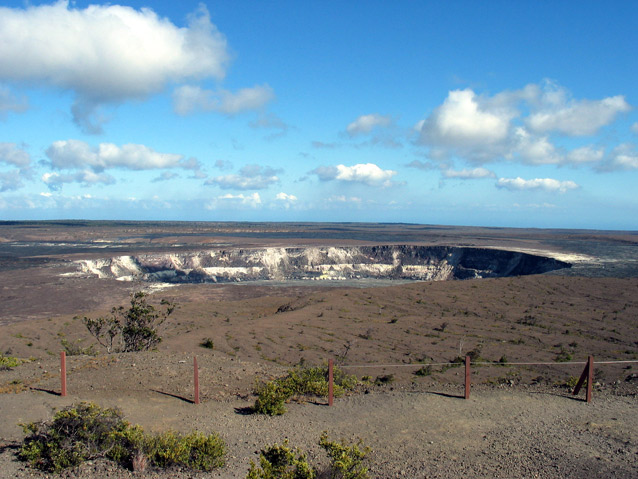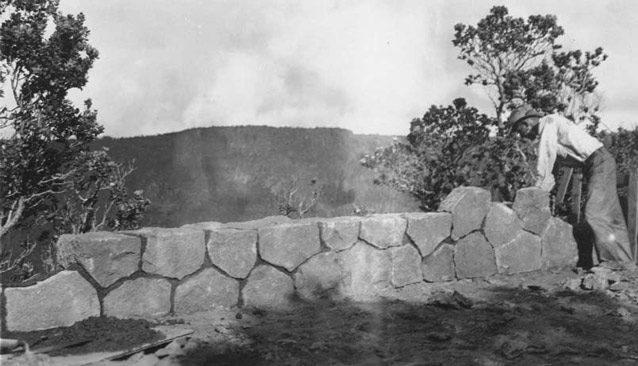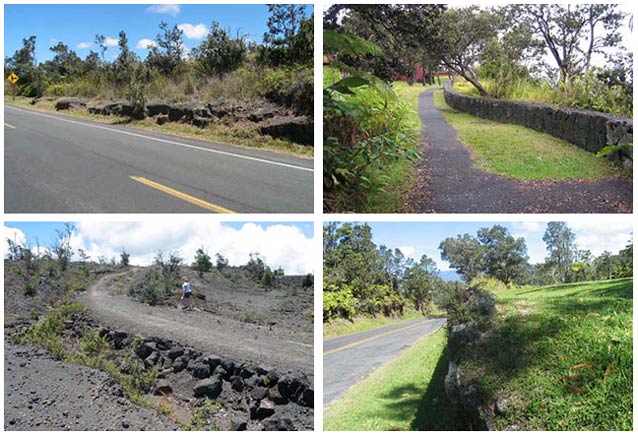The Kilauea Caldera is a 2.5-mile long, 2-mile wide, 400-foot deep caldera that was formed on the island of Hawaii when an underground magma chamber caved in, causing the volcano summit to collapse. The dynamic landscape has drawn non-native visitors since the nineteenth century. The designed features of the park plan provided a way to safely approach the active volcano, incorporating NPS and Hawaiian styles without detracting from the natural landscape.
When Mark Twain stayed at Volcano House in 1866, he described a "neat, roomy, well furnished and well kept hotel. The surprise of finding a good hotel at such an outlandish spot startled me, considerably more than the volcano did." Mark Twain, from "The Great Volcano of Kilauea," Sacramento Daily Union, November 16, 1866.

NPS
Crater Rim Historic District is an approximately 5,000 acre historic district in and around Kilauea Caldera in Hawaii Volcanoes National Park. The district is significant for its associations with early park planning at Hawaii Volcanoes National Park and with the Civilian Conservation Corps (CCC) program. It is also notable for its distinctive design style, which exemplifies the “Park Service Rustic” style and naturalistic landscape architecture perpetuated by the NPS in the period between the First and Second World Wars. The period of significance spans the years 1916 to 1942, covering the period of primary park development and CCC involvement.
Crater Rim Historic District encompasses Crater Rim Drive, a 10.6-mile scenic loop road that takes visitors around the caldera rim and onto the caldera floor. The district also includes the road’s associated features, parking lots, and overlooks; the buildings and developed areas on the caldera rim, including the Volcano House, Jaggar Museum, and Thurston Lava Tube; and the scenic trails that lie within the district.

NPS (HAVO Landscape Architect's Reports, 1934)
Crater Rim Drive begins on the high bluff in the northeast corner of the caldera in the headquarters area. The most developed part of the caldera rim, the headquarters area, includes the Volcano House hotel, visitor center, the Volcano Arts Center housed in the 1877 Volcano House structure, and park offices, residences, and maintenance facilities. From here, the road follows the north bluff of Kilauea Caldera, past Kilauea Military Camp and the Jaggar Museum and Volcano Observatory on Uwekahuna Bluff.

NPS
The road then descends the bluff through the fractured Southwest Rift Zone onto the floor of the caldera. Here, visitors are given the opportunity to park and view Halemaumau, the large crater within the Kilauea caldera that was quite active until the 1930s. From the Halemaumau parking lot, Crater Rim Drive climbs back out of the caldera and past the smaller craters of Keanakakoi and Kilauea Iki, through the tree fern forest, and past Thurston Lava Tube. The loop road rejoins itself in the headquarters area.
Along its route, Crater Rim Drive passes through a variety of contrasting natural settings, offering views into lush forests of ohia lehua trees and hapuu tree ferns, high scrub desert, and barren, smoking lava fields. The sheer cliffs of the caldera and the open vegetation of much of the district allow for spectacular views of the volcanic landscape.
Quick Facts
- Cultural Landscape Type: Designed
- National Register Significance Level: State
- National Register Significance Criteria: A, C
- World Heritage Site
- Period of Significance: 1916-1942
Landscape Links
- Cultural Landscape Inventory park report
- Library of Congress: American Memory Collection
- NPGallery Photos
- More about NPS Cultural Landscapes
Last updated: December 30, 2020
